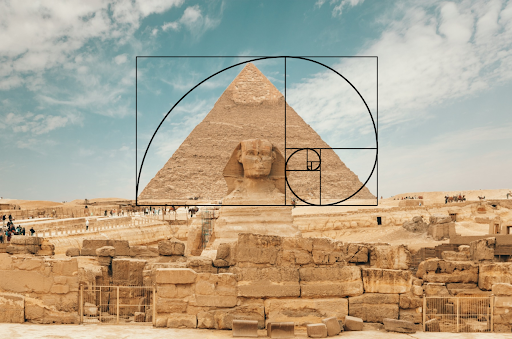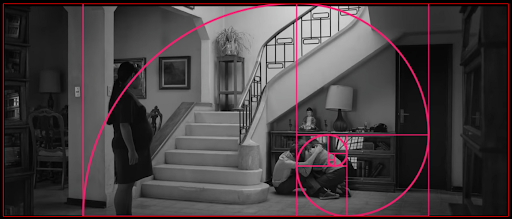Exploring the Golden Ratio in Film and Photography
- Arya Kastwar

- Nov 9, 2022
- 7 min read
While it is true that beauty is perceived differently by every individual, we continue to seek conventionality and be attracted towards it - conventional facial proportions that make one “beautiful”, conventional photography landscapes that make a photograph “perfectly symmetrical”, conventional theatrical frames that “directs perfectly the audience’s attention to the object of focus”.
Now, what is this “perfect proportion” - that so seamlessly and without any conscious effort, let alone within our range of realisation, holds our attention captive - called? And why does it attract our attention in the first place? Of course, centuries of human evolution has led us to an answer, to something we can refer to this divine symmetry as - the Golden Ratio.

Let’s delve a little deeper into the intricacies of this concept and the geometry that lays down the blueprint of its fundamental structure; and how the tool is exploited in film and photography.
In mathematical terms, the Golden Ratio is simply the ratio of the long side of a rectangular frame to its short side - which is 1.61803398874989484820458683436563811772030917980576286213544862270526046281890244970720720418939113748475408807538689175212663386222353693179318006076672635… and it keeps going on with no end! This ratio is known as Phi, denoted by the symbol - Φ.

Too technical? Let’s take a little break and warm ourselves up with a little history of the concept. We know Golden Ratio is nearly as mythical today as it was mathematical at birth - but what or rather, who paved the way to this transition?
The forebearer of the mythicising of Phi was Leonardo of Pisa, or as we all have him, Fibonacci. Unquestionably, this is the same genius of a mathematician who brought the Fibonacci sequence into existence. This order of numbers progresses by adding the two precursive numbers, like - 1, 1, 2, 3, 5, 8, 13, 21, 34, 55… and goes on until the end of the Universe! - or until you simply get bored.
Now, why are we talking about the Fibonacci sequence while speaking of the Golden Ratio? Interestingly, there happens to be a direct relation between the two harbingers of perfect symmetry - as you continue to progress with the sequence, the ratio between the numbers continues to grow ever so closer to Phi! It is a pleasantly amusing happenstance as neither was discovered with the purpose of developing any correlation at all.

The belief that the Golden Ratio exists in everything and everyone makes us question if it is-
Mythology or Mathematics
“Despite Phi’s seemingly mathematical origins, the truly mind-boggling aspect of Phi was its role as a fundamental building block in nature. Plants, animals, and even human beings all possessed dimensional properties that adhered with eerie exactitude to the ratio of Phi to one. Phi’s ubiquity in nature clearly exceeds coincidence.”
The Da Vinci Code, Dan Brown
In a day and age where technology lets us study and analyse anything and everything, it has become easier and significantly more convenient to read recurring patterns and phenomena taking place in the nuances of concepts.
The Golden Ratio is claimed to be absorbed into the very roots of nature. Many believe this holy geometry underlies everything from sunflower seeds to the Great Pyramid of Giza, and everything in between. Photographers, artists, cinematographers, and even biologists and astrophysicists all around the world indulge in the notion that the Golden Ratio profoundly links nature to maths in a way that yields remarkable beauty.
However, as the law of nature has it - every gripping theory is an invitation to sceptics. Although a fascinating stance, one cannot help but question if the Golden Ratio, in fact, exists in everything, everywhere, all at once, or if it is simply our conditioned, pattern-sensing brain that looks for it in everything before our eyes.
The Golden Ratio, being an irrational number on the sole basis of its precision, cannot be considered in terms of a mere close proximity. Phi is not “approximately” 1.6, but an infinite irrational number. When it comes to flawless symmetricality, close enough is not enough.
A classic example of the misportrayal of the Golden Ratio is the Nautilus shell, which has at this point become an unmistakably recognisable mascot of the concept. What it really is is a logarithmic spiral, which lies nowhere on the plane of Phi. This also, in the process, discredits the discrete beauty of the logarithmic spiral alone.

While mythology vs. mathematics continues to be subject to debate, it is an irrefutable fact that the Golden Ratio and other geometrical stencils like the Rule of Thirds greatly help artists hone their skills and produce pieces of art that are admired far and wide by people across the globe - but how does this tool understand the human psyche and help photographers and cinematographers manipulate precisely what the audience primarily perceives amid everything else on the canvas?
Golden Ratio in Photography
While photographing, composition is one of the most crucial aspects to consider to capture the essence of the theme and the subject, without losing the details in translation. A good photographer understands where to place what in a photograph - in a way that directs the attention of the audience to the core in the natural course of curious eyes.
For this very positioning of the subject and objects around it are composition techniques and stencils used - the most common technique being the Rule of Thirds. This technique is profoundly sought after by beginners of photography, and is considered extremely helpful in guiding the placement of objects and camera angles. However, as one advances in the art, the Rule of Thirds is realised to be but the scratching of the surface - the surface far beneath the canopy of which we find the Golden Spiral.

One way to utilise the Golden Spiral in the layout of your photograph is by using the path of the spiral to direct the audience’s attention, following it to the very centre - where the subject of focus lies. This is possibly the most widely used method of employing the Golden Spiral to the lens.

Another way of using the Golden Ratio to your advantage while capturing photographs is the Phi Grid - a simpler visualisation of the technique. Here, rectangles with a 1:1.618 ratio are superimposed over the picture in a grid, dividing it into thirds, both horizontally and vertically. Since the grid does not have the precision of the spiral, it is primarily used for landscapes sparse in terms of details.
Many a photographer clicks pictures by intuition only to realise later the photograph aligns perfectly with the Golden Spiral. This tells us that if not entirely, the Golden Ratio does, in fact, serve our definition of an aesthetically pleasing photograph.
Although, despite its superior proportions in comparison to other techniques, the Golden Ratio cannot be applied to every photograph, as many pictures require different adjustments and compositions.
Golden Ratio in Film
For the same reasons as in photography, the Golden Ratio is sincerely, avidly used in filmography - to capture the moment as we perceive it in nature, and highlight the subject/theme in a way that leaves a deep impression in the mind of the audience.
Alfonso Cuarón's Roma
This mathematical equation helps frame shots better, considering the foreground, the middleground, and the background - yielding just enough attention to the elements in each layer of the frame. While filming, balancing the aspect ratio is an indispensable factor regardless of how exceptionally well one manipulates the colours or spatial depth. There are certain moments in a film the intensity of which depends heavily on the use of the Golden Ratio.
When focusing on the eyes of a character, the height of the frame is usually divided in the proportions of the Golden Ratio, creating the ideal placement for the eyes. Interestingly, this very framing division is also used for capturing the horizon! This is done because our eyes in themselves are placed at the Golden Ratio between our hairline and chin - seeming most natural when positioned to be in proportion with our own face, we look at the screen itself as a reflection of someone looking back at us.
Stanley Kubrick’s The Shining
George Lucas’ Star Wars: A New Hope
Francis Ford Coppola’s The Godfather
David Fincher’s The Social Network
Denis Villeneuve’s Dune
The Golden Ratio helps fit the principal object at the centre of attention while apportioning the other objects in the foreground and background leading in succession to the centre of the spiral. This helps the audience absorb the entirety of the plot laying out in the scene, maximising the impact. Without even realising, the human psyche always follows the spiral until its deepest end.
Although utilised to direct the absolute, undiverted attention of the audience to the subject, the rules of the Golden Ratio are sometimes deliberately flouted to portray chaos, and arouse uneasiness in the audience. This blatant disregard of the composition leaves the attention of the audience wandering across the frame, much like the state of confusion the character is faced with.
The Golden Spiral, or even simply the Phi Grid, which involves the grids alone, leaving out the details of the spiral - holds the power to highlight the very essence of a film, scene by scene. Many critically acclaimed directors like Wes Anderson, Christopher Nolan, Steven Spielberg and many others toy with the concept of Golden Ratio, manipulating it at whim, to achieve with perfect accuracy the response anticipated from the audience.


These are some ways the Golden Ratio shows itself in our lives and the art we create. Being a concept used so extensively, knowingly or unknowingly, we often mistake symmetry to be synonymous with perfection. While artists like Salvador Dali and architect Le Corbusier have been known to use the geometry of Phi time and again, let us not forget that some of their greatest pieces of art involved not in the slightest even the impression of the technique - rendering us with nothing short of perfection.
Nonetheless, in all practicality, it serves as an extraordinary technical tool in several canvases, seamlessly serving the fanciful tastes and aesthetical impulses of countless artists.
Beauty and life are integrally messy. The Golden Ratio helps us find order amid the chaos - but is it really always needed to capture the heart of the subject when expression and art exist in everything from the symmetry of pyramids to the unforgiving abstract of fantasy worlds with distorted realities?













best iptv : Welcome to Best IPTV 4K, your trusted destination for the best in IPTV streaming technology. We provide access to thousands of live TV channels, movies, and series in crystal-clear 4K Ultra HD, bringing you the ultimate entertainment experience directly to your screen.
At Best IPTV 4K, we believe in quality, stability, and simplicity. Our advanced IPTV system is designed to deliver smooth, high-speed streaming with zero buffering and perfect image quality. Whether you enjoy sports, movies, international TV, or kids’ channels, we offer a complete entertainment package to match every taste.
Our service is fully compatible with Smart TVs, Android Boxes, Fire Stick, PCs, tablets, and smartphones, giving you the freedom to enjoy your favorite content anytime, anywhere. We also…